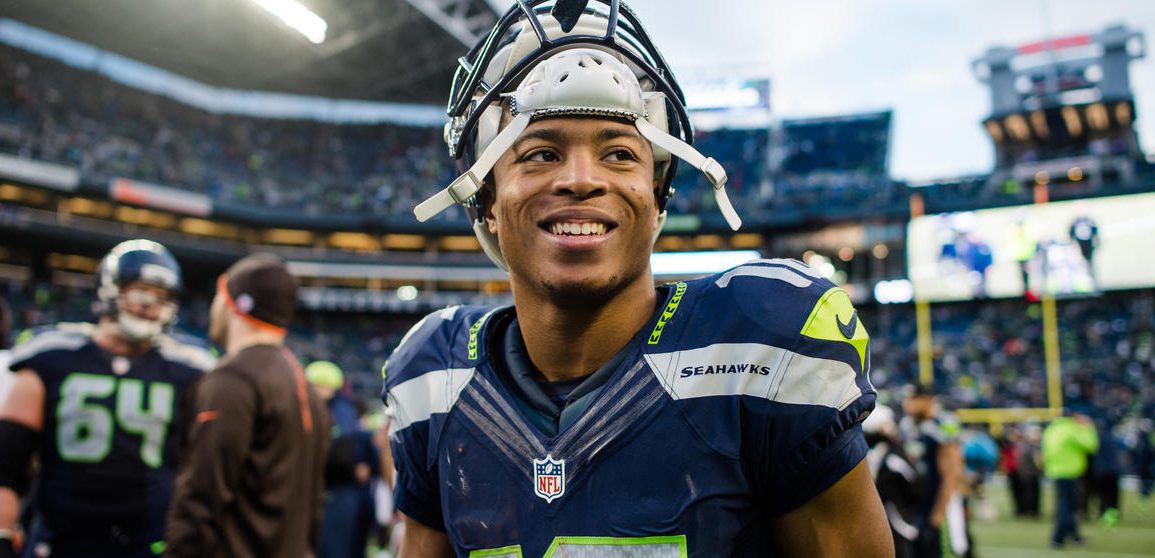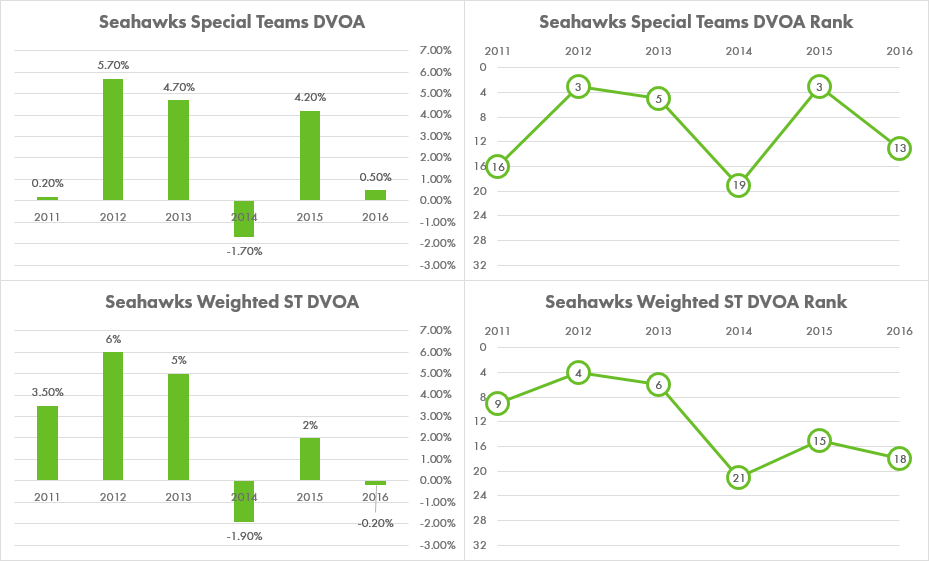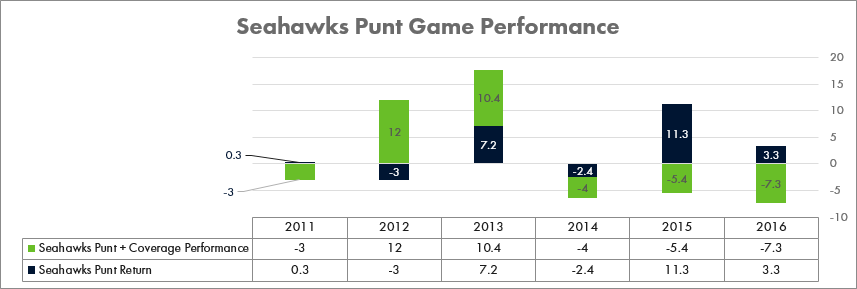There is evidence that the Seahawks have lost touch with the philosophy that helped them rise to the top. How they confront this identity crisis will have a far greater impact on their football fortunes than any soap opera brewing behind the scenes. In this series, we will explore different aspects of Carroll’s philosophy and assess whether the 2017 Seahawks are in position to recapture their dominant formula.
“If you don’t have a clear view of your philosophy, you will be floundering all over the place. If you win, it will be pure luck.” – Pete Carroll USC Coaching Clinic
[divider]Part Four: Special Teams[/divider]
Special teams play rarely get the attention it deserves. An efficient kicking team directly leads to points. Great punting and coverage limits opponent scoring chances. The championship team for Seattle in 2013 entered the last game of the regular season having allowed just 25 yards in punt returns. If not for a smart and risky game-plan from the Rams to double-team both Seahawks gunners (Jeremy Lane and Ricardo Lockette), Seattle would have set an NFL record for fewest punt return yards allowed in a 16 game season. Last year, the Seahawks surrendered 236 punt return yards. The year prior, it was 386 punt return yards. Steven Hauschka had missed only two field goals under 30 yards in his eight prior NFL seasons. He missed two last year alone, along with a whopping six extra points, and was shown the door in the offseason. The special teams unit that was once a strength of this Seahawks team is in question.
Underappreciated elements of special teams
The NFL is an entertainment industry. They are far more likely to showcase a dazzling punt or kick return than a well-struck punt that is fair caught inside the opponent’s 20-yard line. That does not mean one is necessarily more important than the other. After all, both are primarily about field position. Some returns result in points, but those are rare. Tyreek Hill led the NFL in punt return yardage and punt return touchdowns last year, but still only scored on about 5% of his returns. So if it really is about yardage, a shanked punt that goes 15 yards instead of 45 is every bit as impactful of a play as a 30 yard jitterbugging return on a 45 yard punt. On the flip side, if you can punt a ball 40 yards with great hang-time instead of 45 yards with less hang-time to force a returner like Hill to fair catch the ball, you are likely netting a 10 yard gain per kick (Hill averaged 15 yards per return). Why does field position matter so much? Because it has a direct relationship with the chances a team will score.

This chart is pulled from a blog post written by Andrew Schechtman-Rook, where he analyzed all the first downs for all teams during the 2012 NFL season. He then calculated the percentage of drives from those different field positions that ended in points. He excluded the fourth quarter of games to avoid skewed data from teams desperate to score or teams protecting a lead. This is just one of dozens of such studies. All come to the same conclusion—field position is directly related to the probability that a team will score points. A team will score roughly 1 out of every 5 drives when they start inside their own 10 yard line, per the research from Schechtman-Rook, whereas those chances increase to about 1 out of every 3 drives if they are allowed to start at their own 30 yard line.
What Schechtman-Rook’s data does not show is the inverse effect. A team that is pinned back at their own end zone is unlikely to score, and very likely to punt. If you figure the average punt is 45 yards, there is a good chance your offense gets that ball back between their 40 and the opponents 40 yard line. That translated to points about half the time. Football Outsiders does a better job taking into account the potential for points created or points surrendered in their DVOA formula for special teams. Take a look at how Seattle has fared over the past few years.
The top row shows the standard DVOA for the Seahawks special teams, along with their rank in the NFL for that season. You can see a pretty steep decline after the 2013 season, with 2015 being the exception. That was Tyler Lockett’s rookie year, and his production on kick and punt returns, along with a great season for Hauschka, helped buoy the Seahawks in the rankings. The second row indicates the Seahawks weighted DVOA each season, which is a better indicator of how the team was performing as the year progressed. It puts less of an emphasis on early season games. There are two things worth noting there:
- The Seahawks went from a top ten special teams unit in 2011-2013 to a bottom-half unit the last three years
- Seattle’s special teams performance improved as the year wore on from 2011-2013, but deteriorated each of the last three years late in the season
The way to arrive at that second conclusion is to compare standard DVOA percentages to weighted DVOA percentages for each year. When the weighted DVOA is higher than the standard, it means the team was performing better as the year progressed. When it is lower, the inverse is true. This is not a rosy picture for the Seahawks special teams.
The importance of the punt game
Football Outsider’s arrives at their DVOA rankings by looking at five key aspects of special teams:
- Field goals + extra points
- Kickoffs + kick coverage
- Kick returns
- Punts + punt coverage
- Punt returns
The Seahawks have been relatively consistent in kickoffs and kick coverage, and have improved on kick returns, so those are not the key culprits in the special teams decline. The new kickoff rules that move the kickoff line forward and give teams the ball at the 25 yard line for touchbacks decrease the importance of that element of special teams anyway. Punting, however, is just as critical as it ever has been, and the Seahawks punt game has been an issue.
Football Outsiders scores the five elements of special teams by applying a point value. You can read the full explanation here. Simplistically, you can read the values above as points above or below the league average. So, the 2013 Seahawks were 10.4 points above the average NFL team in punting and punt coverage, whereas the 2016 Seahawks team was 7.3 points below the NFL average. Similarly, the 2015 Seahawks were 11.3 points above the average NFL punt return team (they were actually the league leaders that year), but just 3.3 points above the league average last season.
If you combine both aspects of the punt game, returning and punting, the Seahawks went from a combined 17.6 points above the league average during their championship season to -4 points last year. That is a massive swing.
It is hard to quantify, but that is likely one of the biggest differences between the championship Seahawks and the divisional round-losing Seahawks. This team is leaking yards, and therefore points, in the punt game. More specifically, the punt plus punt coverage aspect has fallen off significantly. Seattle has been negative in that aspect of their special teams for the last three years.
Coverage units in question
The 2013 squad had Lane and Lockette acting as gunners. Both players barely saw snaps doing anything else. One year later, Lockette was the fourth receiver and Lane was the nickel corner. It was just one example of how a reduction in depth impacted the team in ways most did not notice. Heath Farwell and Chris Maragos were key special teams contributors. Maragos left for Philadelphia the following year and Farwell retired. Brock Coyle has been a good special teamer, and Neiko Thorpe was a solid addition last year, but one could argue the team has yet to replace what Farwell and Maragos provided.
Jon Ryan may be on his last leg
Jon Ryan is somewhere just below Marshawn Lynch and Russell Wilson in terms of Seahawk fan adoration. He seems like a great guy, who is easy to root for. He is also 36, and there is evidence that his game is slipping.
Looking at just this chart, you would have to wonder if Ryan is still the best guy to handle punting duties for the Seahawks. He is near the bottom of the league in both average distance of his punts and net distance (average distance minus return yards). However, Ryan’s average punt last year (44.0 yards) was longer than his average distance in 2013 (42.7 yards). That seems less like a physical issue, and more like a coverage issue. There is a third possibility. The Seahawks asked Ryan to change his approach to punting in 2013:
For much of his career, Ryan fashioned himself as a power punter. His booming kicks sent returners backpedaling. They would also sometimes arrive before his coverage unit did, which created a bit of a problem. So in consultation with the coaching staff, Ryan adapted. He altered his style at the beginning of the season, making an adjustment akin to a hard-throwing pitcher improving his control by paring a few miles per hour from his fastball.
Instead of kicking the middle of the ball with the top of his foot, which would send it spiraling, Ryan hits it on the nose with his toes. This Aussie-style approach, as Ryan calls it, adds precious tenths of seconds aloft, as well as backspin, and the ball thumps the turf as if struck by a pitching wedge, bouncing toward him — and away from the end zone. According to game charting by the analytical website Pro Football Focus, only 28.4 percent of Ryan’s punts were returned, the second-lowest percentage in the league.
“In a way, it’s a sacrifice,” said Ryan, whose average of 42.7 yards is the second-lowest of his eight N.F.L. seasons. “When you’re punting in the manner that we’re punting, it’s pretty impossible to have gaudy numbers like some other guys do. But at the same time, I love it because that’s what’s helping the team.”
Source: New York Times
Given Ryan’s punting average popped back up to 44.1 in 2014, then 45.7 in 2015, and finally 44.0 last year, one has to question whether Ryan abandoned what had been working so well in 2013. Another article tackled this topic to some extent, and concluded that Ryan is still doing the Aussie-style kick on many occasions, but has also utilized the bigger distance kicks when Seattle gets pinned farther back. Those longer punts were not getting any additional hang time, giving coverage teams less time to get downfield to the returner, resulting in far longer returns. The percentage of Ryan’s punts that are getting returned has increased as well.
Some of this speaks to coverage, but the style of punt being utilized is playing a key role as well. It also seems like younger punters are getting the best of both worlds. Johnny Hekker (27) averaged 47.8 yards per punt last year and 46.0 yards net. A whopping 52% of his punts pinned opponents inside their own 20. Bryan Anger (28) of Tampa Bay had a league-best 53% of his punts downed inside the opponent’s 20 yard line. Ryan, by comparison, was at 36.6% last year, and 35.3% the year prior. His percentage of punts that are fair caught have dropped from 40.5% in 2013 to 29.4% in 2015 and 31% last year. Hekker and Anger are at 41%.
That is part of why I have been surprised the Seahawks have stuck with Ryan and his veteran salary that costs $1.6M on the cap each year instead of drafting a younger player or signing a less experienced free agent to at least compete with Ryan. This was such a huge weapon for the championship Seahawks. It warrants more attention on the personnel side.
Gambling on the kick game
The punt game is the most obvious area requiring improvement on special teams, but the kicking game became an issue last year. Where Hauschka and the Seahawks had been consistently positive in the Football Outsider ratings for field goals and extra points, they plunged into the negative last season (-4). Some of this was due to a rookie snapper in Nolan Frese who struggled a lot early on, and appeared to impact Hauschka’s rhythm and confidence as the year progressed. Some of it was a faulty offensive line that had trouble holding the point of attack in the middle of the field, resulting in penetration and a whopping six blocked kicks. Some of it was Hauschka kicking the ball too low. It was an off year for what had been a strength of this team.
The decision to let Hauschka go is a questionable one. This is a guy who has been one of the most consistent kickers in team history and across the league. He has made kicks at big moments, and has been remarkably accurate from beyond 50 yards (12-14 since 2013). In his place, the team signed Blair Walsh.
Walsh is most known for his shank against the Seahawks in the playoff game in Minnesota that cost the Vikings the win. What most do not know is he is five years younger (27) than Hauschka (32), and was a 1st-team All-Pro as a rookie in 2012 when he made a remarkable 10-10 from beyond the 50 yard line and 35-38 overall. He was 6-8 from over 50 yards as recently as the 2015 season and has never had an extra point blocked. He has, however, missed eight extra points in the last two seasons.
None of Walsh’s contract is guaranteed, and the team may bring in another leg to compete with him during training camp. Given how big a role the mental part of the game plays in kicking, Walsh will not truly recover from his playoff mistake until he comes through for a team in a similar situation.
Where Seattle can improve on special teams
The first name that came up when I was recently talking with a Seahawks coach about special teams was Michael Wilhoite. The former 49ers linebacker was a sneaky good signing who should add a lot to the defense, but also to the special teams group. He may be the first legitimate replacement for Farwell. The team also brought back CB Neiko Thorpe and LB Dewey McDonald, who were first and second on the team in special teams tackles last year. Tanner McEvoy returns as a guy who blocked a kick and improved as the year went on. Safety Bradley McDougald was a big part of the Tampa Bay special teams, and joins Seattle this season. Then you have a number of athletic rookies who figure to play a prominent role:
- Shaquill Griffin
- Mike Tyson
- Algernon Brown
- Tedric Thompson
- Delano Hill
- Amara Darboh
There are other sleepers out there like speedster Cyril Grayson. This should be a special teams that is younger and more athletic. Frese will face competition at long-snapping from Tyler Ott, and should be better after his rookie struggles. Tyler Lockett will hopefully be back to full health and ready to be a threat on returns. We may see C.J. Prosise or someone else take on kickoff returns to lighten Lockett’s load.
The biggest question mark has to be Walsh and the kicking game. That is something the Seahawks have had the luxury of counting on for most of the past six years. Everyone will be holding their collective breath when the team lines up for kicks this year. The largest opportunity for improvement is in punt coverage. Seattle has some excellent athletes to get after returners. As it appears Ryan is a lock to be the punter this season, fans should hope the team encourages him to return to more of his Aussie-style kicking to reduce the number of returnable kicks.
Special teams was a dominant factor in helping the Seahawks hoist their first Lombardi Trophy. It can be again.




